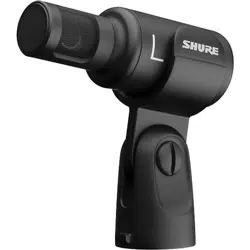Loading ...
Loading ...
Loading ...

Shure Incorporated
10/17
1.
2.
◦
◦
◦
3.
Polar Pattern Selection (Stereo and Mono Settings)
Thefollowingdemonstratesmicrophonecapsulepick-uppatterns.Whenoperatinginamonomode,stereowidthisnotad-
justable.
Stereo
Front = On
Sides = On
Mono Cardioid
Front = On
Sides = Off
Mono Bidirectional
Front = Off
Sides = On
Raw Mid-Side
Front = On
Sides = On
See "Raw Mid-Side Output" for more information.
Raw Mid-Side Output
For increased post-processing flexibility, use the Raw Mid-Sidesetting.Thisrecordssignala2-channelsignalwithastereoim-
age that can be adjusted even after the tracks have been recorded:
Left: Cardioid (front)
Right: Bidirectional (sides)
Use the Raw Mid-Side setting with audio recording applications that have a mid-side stereo matrix decoder. Or use the manual
decoding instructions to adjust the stereo image of the recorded tracks.
Manual Decoding and Stereo Width Adjustment
If your digital audio workstation software (DAW) has no mid-side decoder, use these steps to adjust and manipulate the stereo
image:
Extract the left and right audio signals from the 2-channel Raw Mid-Side file as individual mono tracks.
Create 3 blank audio tracks:
First track: Use the audio signal (front/cardioid) from the left channel only as a mono track, panned to the center.
Second track: Use the audio signal (side/bidirectional) from the right channel only as a mono track, panned all
the way to the left.
Third track: Copy the side/bidirectional signal from the second track. Pan this track all the way to the right and re
verse the phase.
Group the right and left side tracks, and set the volume at the same level for simultaneous adjustment. Increasing the
volume of the grouped tracks increases the stereo width, while decreasing their volume narrows the width.
Advanced tip: Using compression with a fast attack setting on the grouped tracks keeps transients (the first part of a sound, such as when a drum stick strikes
a cymbal) toward the center of the stereo image and allows them to expand within the stereo field as the sound decays.
Loading ...
Loading ...
Loading ...
